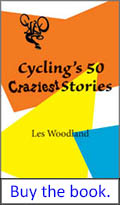

Criterium Racing Tips 102 (Beyond the Basics)
By PCG Master Coach BJ Basham
Back to Training and Fitness index page
Even if you race and train with tons of power, if you use it wastefully, you likely won’t get the results you hope for. When it comes to racing criteriums and circuit races, where you have to react quickly, and mistakes can mean the end of your day, being smart with where you use your matches can mean the difference between being in the race, and just fighting to survive.
So here's advice I give my riders that goes beyond the basics.

Les Woodland's book Cycling's 50 Craziest Stories is available as an audiobook here
That’s a lot of sprints
Back in the '90s, I went to a race, and a friend of mine and I were sitting in the parking lot before the race. He gave me some great advice which now seems really logical and intuitive. In a race with 4 corners, and 20 laps, that can mean 80 sprints, not counting the sprint to the finish or primes etc.
That’s a lot of sprints.
I watch riders at every event stomping their way out of corners over and over again, until they just can’t do it anymore. But the most successful riders ride their bike like they would drive their car, shifting down going into turns, and then spinning up through the gears as the speed comes back up so they could save more of their matches for trying to win the race.
The key to saving your matches in a race is to avoid the big peaks in power, and that includes not making huge acceleration out of the corners. Positioning plays a big part in this, but even if you are sitting right up in the top 10 all day, you can still be wasteful or inefficient with how you ride.
This can take some thought and practice. Looking at the course before the race and even doing a couple of hot laps taking the turns at speed is a useful part of any warmup. But also doing workouts where you practice accelerating quickly on a lighter gear and working your way through the gears as your speed builds, can help you to know not just what it feels like, but might also might highlight parts of the equation such as leg speed, your gearing choices, or even how brake/shift levers are positioned, that might need to be improved or adjusted.
Race your strengths (if you are not a sprinter, don’t wait for the sprint)
Criteriums tend to be thought of as events tailor made for sprinters, but we have all seen crits won in other ways like a late race attack or even a jump from the gun. I once knew a rider who was not a good sprinter at all, but he got many of his upgrade points in criteriums. His trick was to lead out every finishing sprint so that he was at the front and the sprinters would have to get past him if they wanted to win. He knew that there was no way, with his power, he would be able to come around a good sprinter at full speed, but if he led out the sprint, he was likely to at least hold on to a top 10 spot at the finish if not actually win the race.
The point is that any rider can try to win a criterium with tactics that fit their specific strengths and weaknesses.

A tactically smart rider can beat a faster racer. Here, in the final stage of the 2017 Tour de France, Dylan Groenewegen has won the stage, even though André Greipel was going much faster. But Greipel passed Groenewegen after he crossed the finish line.
A strong time trial rider might want to go for a long break away. An all-arounder might try to reduce the group that they have to fight it out with at the finish by launching attacks late in the race when the field starts to get tired. Even a strong sprinter might want to approach the finish of a specific race differently based on who they are racing against. Maybe a late attack in the final kilometer that catches faster sprinters off guard.
At your next crit, if you are not chomping at the bit for a bunch sprint, think about how you can go for the win in a way that suits you. If you are not a sprinter, don’t wait for the sprint.
Back to Training and Fitness index page
.








